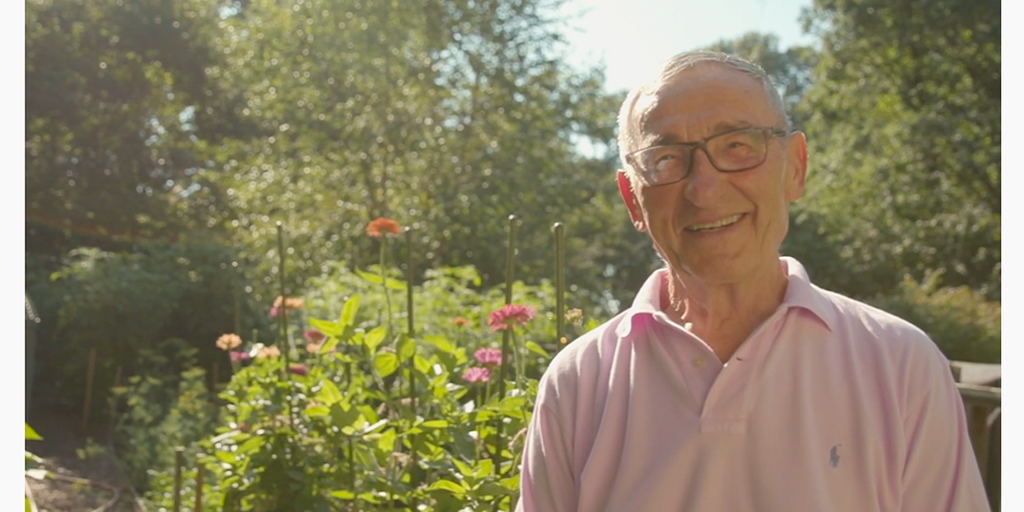
“I’m a Holocaust survivor and…” : reflections on the USHMM ‘Next Chapter’ video series
“I’m a Holocaust survivor and…” : reflections on the USHMM ‘Next Chapter’ video series
Earlier this year, the United States Holocaust Memorial Museum (USHMM) published a new digital media project, ‘Next Chapter’, across their Facebook, Twitter, YouTube, and Instagram channels. The series of six videos feature Holocaust survivors talking about the hobbies of their postwar lives in ways that are framed by their memories of the Holocaust. Publicly viewable replies and comments to the videos suggest that the series is forging emotional connections with digital audiences, as individuals identify and empathise with the survivors through shared interests. This week’s blog from guest contributor Lauren Cantillon asks how do the videos broaden our ideas of the ‘Holocaust survivor’ figure, while also offering a vision for creating a connective digital Holocaust memory?
I spend a lot of time listening to and watching Holocaust survivors recount their personal memories as part of Holocaust testimony gathering projects. The majority of these recordings are several hours long (four hours is a quick one!) and so I often feel emotionally invested in that person by the time I finish listening to their story. With that in mind, it is a constant personal frustration that many testimony projects do not also allow much space for survivors to recount their postwar lives. Yes, we may hear about or even see family members in the recording, but postwar lives are often quickly summarised, leaving a viewer very well informed of who a survivor was, but maybe not so much of who they are in the present moment of the recording. To an extent this is understandable – these are Holocaust testimony gathering projects after all – but I am always left wanting to hear more. How does a person navigate the world after surviving genocide, and who are they beyond being a Holocaust survivor?
Next Chapter
I first came across the USHMM ‘Next Chapter’ project through watching Nat Shaffir’s video, ‘Putting Down Roots’, and was immediately excited by the potential of this style of ‘survivor media’ (for want of a better expression) as something different from more traditional styles of testimony videos. The people featured in the series are all (child) Holocaust survivors, but they are given the opportunity to speak beyond that as their sole marker of their identity, sharing more universal reflections and experiences that are also part of their sense of self.
In the garden with Nat Shaffir
Shaffir is incredibly endearing, drawing a viewer in by talking about his enjoyment of pickling the produce that he grows in his garden plot, and we see him performing this process; ‘it’s a continuation of different generations of pickle makers’ he says beaming at the camera. These feelings of endearment feel further heightened by the aesthetic qualities of the film – beautiful colour saturation of the fresh vegetables, upbeat music, great lighting; everything feels very warm.
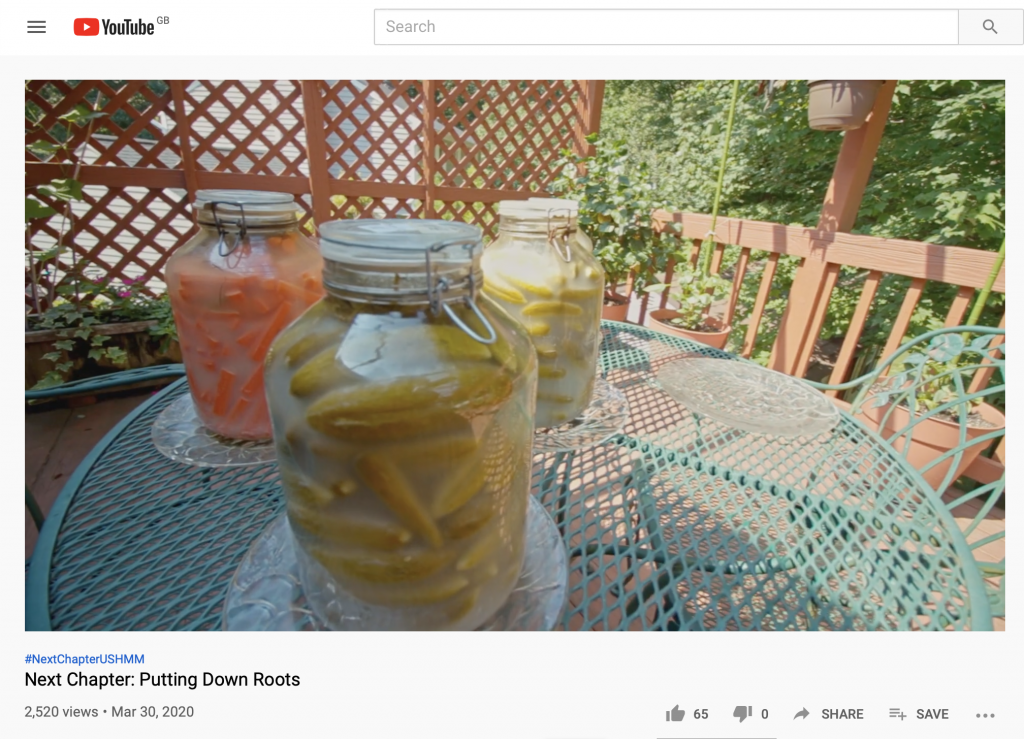
Nat Shaffir’s garden bathed in sunlight, with a trio of freshly full jars of pickled vegetables on a the table
Shaffir connects his love of gardening to having grown up on a farm in Romania, again citing his father who ‘taught me to appreciate what the land can give us, what nature can give us’. This remembering leads us into Shaffir’s Holocaust-specific memories; his Hungarian family were taken to Auschwitz, and he and his immediate family were taken to Iasi where they, being farmers, were at an advantage to ‘city people’ because they knew what wild plants could be safely eaten when other food supplies were low.
Shaffir’s reflective advice, that
‘the hardships on the farm teaches you that, sometimes, in life you have hardships, and you try to live with it’,
further entwines his Holocaust story with his present gardening knowledge and Holocaust survivor status – as a child he took strength from the land in order to survive, and his comments suggest that his identity as a survivor is intertwined with the land. One wonders if this can work backwards somehow, with present gardening ‘hardships’ like a less successful crop evoking memories of hardships during the Holocaust.
In the present, Shaffir’s garden is a place of love, joy and growth (literally as we see the plants flourish over seasons). He is ‘exhilarated’ by what the garden may produce, and also how it brings his family together – his relationship with his grandson (also part of the film) echoes his own memories of time with his father on the family farm.
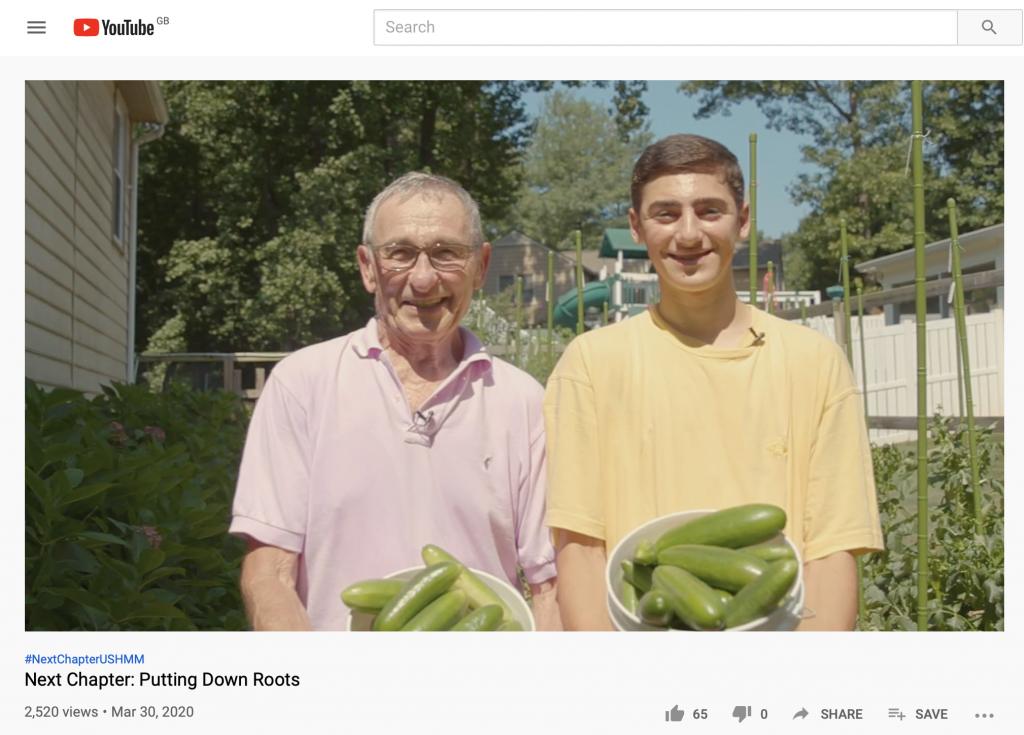
Nat Shaffir and his grandson holding their harvest of cucumbers
The video ends on an uplifting note, with Shaffir again beaming to camera and speaking:
‘my name is Nat Shaffir, I’m a Holocaust survivor, environmentalist, and a gardener’.
This layering of identities – repeated at the end of each ‘Next Chapter’ video as ‘I’m a Holocaust survivor and [blank]’ – is the strength of this media project; Shaffir’s memories of the Shoah are included, reflecting that he is a survivor, but in a way that also leaves space for him to be other things and publicly share those parts of himself with an audience.
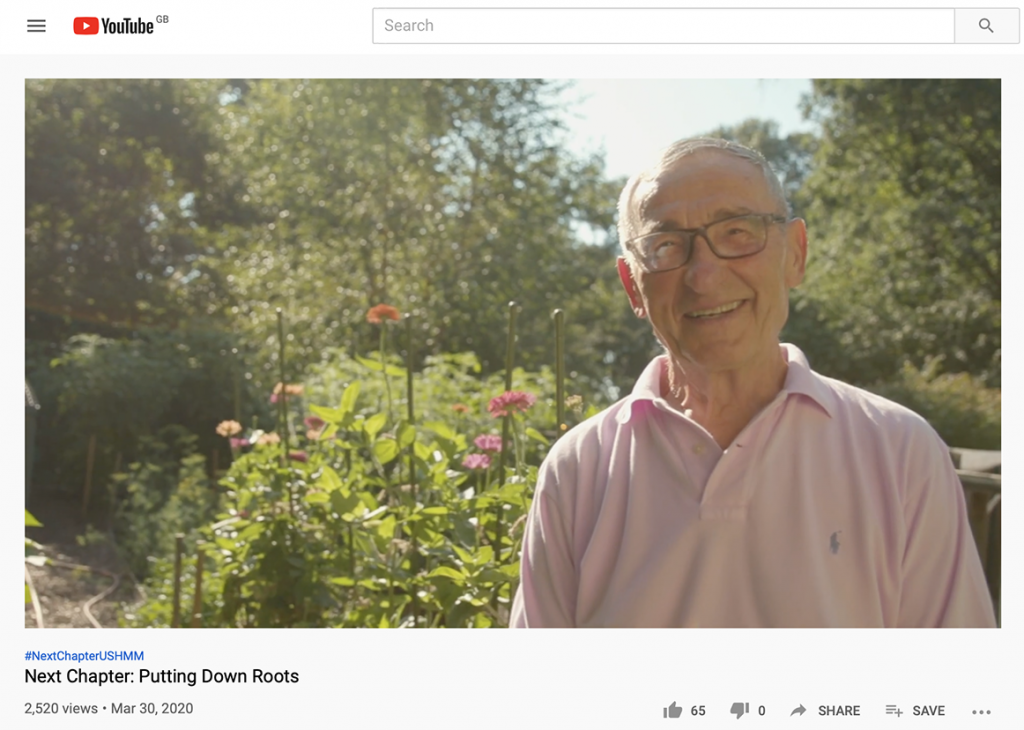
In his garden, Nat Shaffir beams in the final moments of ‘Putting Down Roots’
Shaffir is engaging; he feels like he could be your grandfather, or the kindly neighbour from a few doors down who gives you the spare tomatoes from their garden. I am not alone in experiencing such a positive emotional connectionto Shaffir’s video. When shared on the USHMM’s Facebook page, one commenter replied:
‘This is wonderful and heartwarming after such evil!’
Several commenters express that Shaffir is a
‘beautiful man’,
and more leave a one word response of
‘amazing’.
On Instagram users reacted in similar fashion, with comments like
‘this has warmed my heart’,
‘I absolutely LOVED that!’,
and
‘That! Was wonderful! May his gardens always be bountiful!’.
Emoticons related to gardening and the earth (e.g. the tomato, the cucumber and green hearts) were also part of the response, as well as users tagging friends and business accounts related to farms and general greenery so as to ‘spark some joy’. Such responses suggest that Shaffir’s narrative has connected with the USHMM’s digital audiences, and particularly because of his identity as a gardener.
Professional and democratised memory?
The way these videos have been produced to be shared via an institution’s digital platforms as online media is significant. As described by Christian Fuchs, the drive by large corporations to monetise the digital social spaces of Web 2.0 meant commercial interests overwhelmed individual ones, leading to a prioritisation of professional content over more personal outputs. The USHMM can lean in to this professional privileging as part of its mandate to challenge the antisemitism and Holocaust denial also present on social networking sites (Terry; Cohen-Almagor). Yet the ‘Next Chapter’ project shows it is possible to do both, combining the resources of an institution and utilising its platforms to share personal stories at the micro level; professional and democratised memory, together.
In the pool with Peter Gorog
Another video in the series is ‘Propelling Forward’, in which we meet Peter Gorog. We see Gorog swimming, something he learnt as a child in Hungary, but he shares the realities of swimming now, that ‘sometimes swimming is not fun’. He continues:
‘what helps me through those moments is that I think about my father – he was taken to the first labour camps during the Holocaust and he perished in 1943. I am sure that until his last breath he did everything he could do to survive and to come back to his family and, I think if he could do what he did then I can do the next ten minutes and the next ten minutes.’
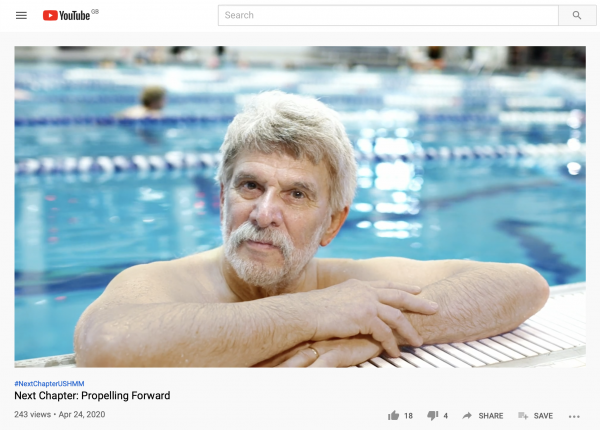
Peter Gorog leans poolside, looking directly into camera
Gorog’s determination, inspired by imagined memories of his father’s own perseverance is something inherently relatable – who hasn’t been in the middle of something and found it difficult to carry on? Part of the video, Gorog’s human struggles in the swimming pool and his emotional response to those struggles are how a digital audience connects to him. When the video was shared through the USHMM’s Twitter account, a reply reads:
‘This is a poignant video, very special for another swimmer such as myself.’
Connective digital Holocaust memories?
That people are commenting, sharing and ‘liking’ the videos calls into question Wulf Kansteiner’s (2017) assessment that
‘connective, emergent digital Holocaust memories exist in some social media contexts, but not in the institutional settings designed to teach Holocaust and genocide memory’.
The USHMM considers its social networking channels as an extension of the institution, with its Facebook page explicitly stating its purpose as a place to
‘memorialize the Nazis’ victims; launch discussion about the Holocaust and its relevance today; and raise awareness that antisemitism, hatred, and genocide are ongoing threats and that we each have a role in combating them’
among other things. I propose that the highlighted responses from the two ‘Next Chapter’ videos discussed suggest the USHMM have been successful in creating and sharing connective digital Holocaust memories in an institutional context, even if the videos are absent from their own website.
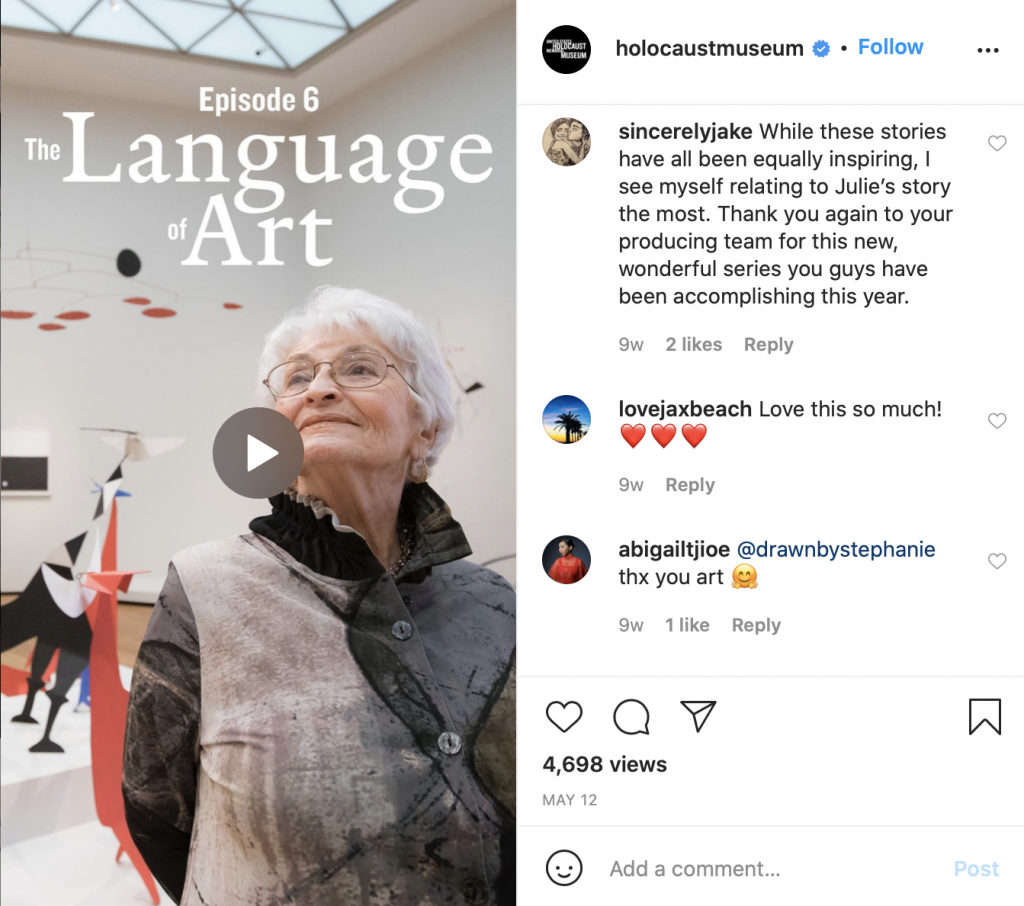
Comments on some of the other ‘Next Chapter’ videos as shared on Instagram – a user directly identifies as relating to Julie Keefer (L),
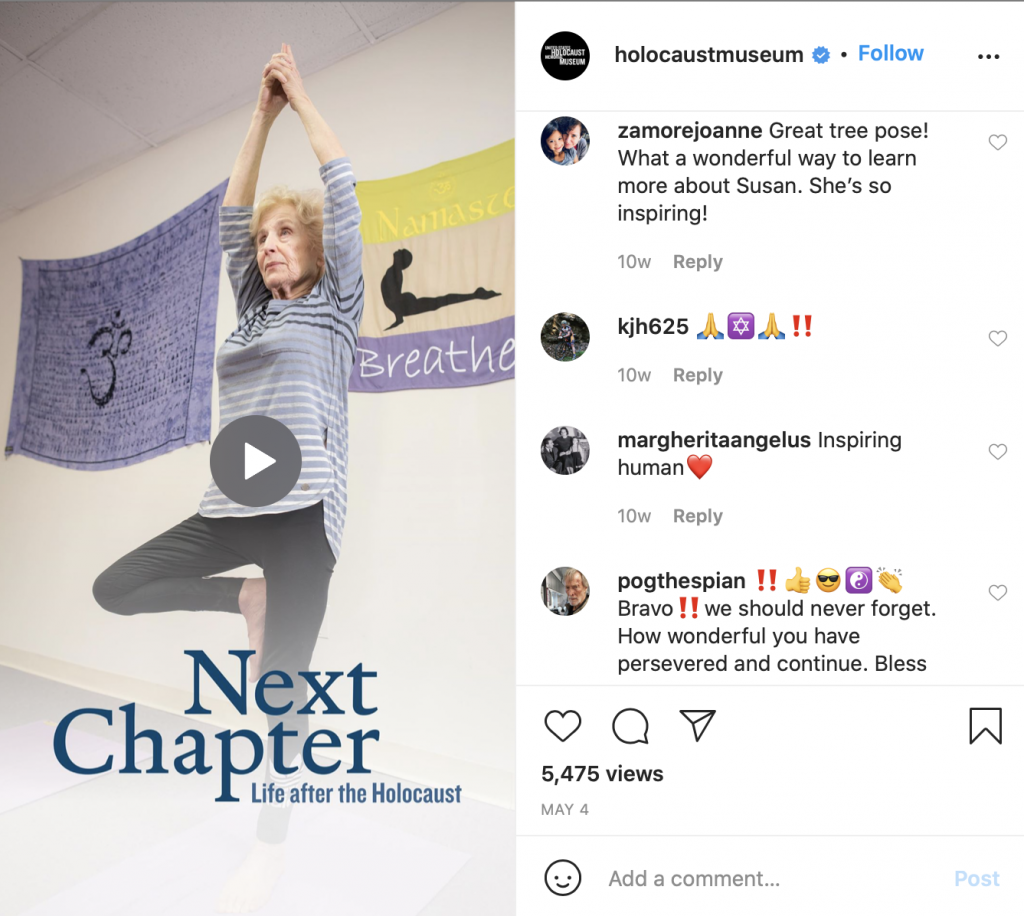
Comments on some of the other ‘Next Chapter’ videos as shared on Instagram – a user directly identifies as relating to Julie Keefer (L),
Holocaust survivors are not just Holocaust survivors. They are layered human beings with interests and hobbies and passions that are both separate from and interwoven with their pasts. The personal stories of the men and women who make up the ‘Next Chapter’ series are simultaneously special and ordinary – special because they are different, and ordinary because they speak to universal human themes.
Nat Shaffir, Albert Garih, Louise Lawrence Israels, Peter Gorog, Susan Warsinger, and Julie Keefer are not just offering testimony of genocide, but testimony that gardening, swimming, the arts, yoga, and more can help someone through life, bringing moments of joy and growth after any kind of pain. As institutions think about what the digital space can offer in terms of ‘edutainment’, maybe ‘Next Chapter’ offers a blueprint that both humanises our understanding of the figure of the Holocaust survivor and connects global audiences to their stories in a new, more personalised, way.
Lauren Cantillon is a second year PhD candidate in the Department of Culture, Media & Creative Industries at King’s College London. Her PhD research is focused around how Jewish women recount personal memories of sexual(ised) violence during the Holocaust, with particular attention to themes of embodied and corporeal memory, emotion(s) and shame. She is the USC Shoah Foundation Centre for Advanced Genocide Research Robert J. Katz Fellow 2020-2021 and may also be found as @lc_explores on Twitter.